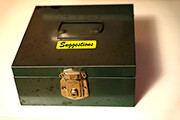It is called the Japanese miracle — the kaizen teian — and the concept successfully provides a way for employees to propose more efficient ways to work.

The History of Suggestion Boxes 1894: NCR Corp. established the first suggestion box in the United States after an official visited a duke's estate in southern Italy. There, employees could submit ideas about how to run the estate more efficiently. 1898: Eastman Kodak set up an employee suggestion program. 1913: The Post Office started its suggestion program. 1914: Prudential Insurance Co. held a four-month contest, and paid $75 for the best suggestion. 1941: General Electric accepted 12,453 of 40,834 suggestions it received, and paid $95,000 in awards. World War II: The War Production Board prompted companies to turn suggestions into a war effort. Companies established Century Clubs for employees who earned more than $100 for their suggestions. Bausch & Lomb doubled cash awards and publicized winners on the radio. 1950: W. Edwards Deming traveled to Japan to guide the nation's post-war industrial recovery. He brought home the concept of continuous improvement and employee suggestion programs quickly became more common. |
Today, this variation of the suggestion box can be found at many American companies. Yet despite the proven effectiveness of these suggestion programs, it's estimated that only 7% of U.S. companies use them.
In many companies without programs, employees feel their suggestions fall into a black hole. Managers may think some ideas are mediocre or frivolous and the overall consensus is that creativity simply isn't encouraged.
But before you dismiss ideas that come from your company's rank-and-file, consider this rule of thumb: While many of the thoughts generated will be worthless or already in place, as many as 50% of the ideas can save you money and help your operation become more efficient.
If you have a suggestion box, or want to set one up, the primary goal is to motivate employees to use it. Here are eight ways to make your program a success:
1. Publicize your program. Whether you use an actual box, an online version, or a combination, give your project a name. A catchy title like Operation Efficiency galvanizes attention. Announce the program and continue to publicize it by mentioning it on posters, in newsletters and through e-mails. Discuss the ideas at team meetings and make it clear that all suggestions will be considered.
2. Provide incentives. Acknowledge everyone who submits a suggestion. Offer rewards for the best suggestions. The reward doesn't have to be big but it should have some meaning. Some companies calculate a year's savings from a suggestion and pay the employee a percentage of that. Others give out special mugs or certificates. Some firms even offer consolation prizes.
3. Consult with employees. Treat employees with good ideas as consultants and discuss the pros and cons of the suggestion. Give them more background or information and challenge them to further develop the idea.
4. Think outside the box. An idea that may seem frivolous or weak at first glance may have some nugget of truth that can be the basis for change. Treat suggestions as brainstorming sessions and don't dismiss ideas until they've been looked at from every perspective.
5. Focus on big and small. Nearly every employee can come up with an idea about how to do the job better. Let your staff know the company is not asking them to redesign the entire production line. Instead, you are interested in suggestions — however small — that make money or improve quality. Make sure employees understand how the company earns a profit and how they contribute to the bottom line.
6. Teach creativity. Train your employees how to come up with ideas, express them in writing and put them into effect. You'll get better suggestions and you'll train your staff to be better problem-solvers and decision-makers.
7. Appoint an overseer. One person should run the project. Suggestions should be picked up daily and acknowledged within a week, regardless of their value. If evaluating an idea takes some time, tell the employee and give updates. Some companies publicly post all suggestions, along with comments on the progress. If a change can be made immediately, don't delay. Morale and productivity rise when employees know their ideas make a difference.
8. Keep it simple and fun. Don't bog your program down in paperwork. Develop a form that's simple but requires enough detail to make a decision. Employees prefer an open system they can work with.
Suggestions may generate pure net profit and the cost of making a change can produce quantum leaps in savings. Let's say you have 100 employees who come up with 100 ideas to save just one dollar a day. With 250 working days a year, that's a saving of $25,000. If your net profit margin is 5%, the savings are the equivalent to increasing your sales by $500,000. Can you think of a simpler way to make that kind of money?



